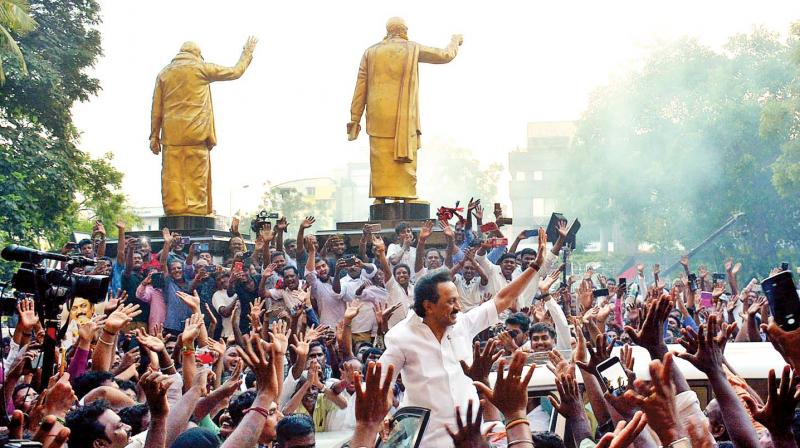Stalin reclaims Kalaignar’s legacy

Chennai: Rarely does politics gifts its practitioners with both hands. Euphoric success on the one hand unravels new challenges at another level.
The DMK president Muthuvel Karunanidhi Stalin leading a nine-party secular democratic alliance including the Congress and seven other parties to a spectacular win in the 2019 Lok Sabha elections in Tamil Nadu on Thursday is a moment of triple affirmation.
Being the first major election he has led after his father and party patriarch M Karunanidhi’s demise in August last year, the DMK-Congress combine virtually sweeping all 39 Lok Sabha seats in Tamil Nadu and Puducherry, is first and foremost an affirmation of Mr. Stalin’s “unquestioned leadership” of the party as the DMK spokesperson Saravanan put it in one of the first post-win reactions.
This is the first affirmative-stand; for this win is not only vital for Mr Stalin to demonstrate that he “can win elections convincingly” for the DMK when several political observers cynically wrote him off as not getting enough seats for the DMK kitty. Having been in the shadow of his matchless father for long years, this victory also symbolizes Stalin reclaiming ‘Kalaignar’s legacy” in a sense.
His elder brother M K Azhagiri’s frequent taunts and barbs at the younger sibling would now just be vintage twitter, with everyone in the DMK including his half-sister Kanimozhi fully accepting Stalin as the political successor to ‘Kalaignar’, a place he patiently reached in a five-decade career of hard political work. It was Mrs Indira Gandhi’s Emergency that was Stalin’s ‘political baptism by fire’ Karunanidhi once remarked, referring to when cops first asked to arrest Stalin.
The second strand of this affirmation is that Stalin’s feat resembles yet another spectacular DMK-led alliance victory it registered in the 2004 Lok Sabha polls under Karunanidhi’s leadership. That alliance too had the Congress as a principal partner after ‘Kalaignar’ had then projected Sonia Gandhi as the PM candidate, besides the CPI, CPI(M), the Vaiko-led MDMK and the IUML being its key allies.
Precisely, 15 years later, Stalin had forged a similar alliance after proposing Rahul Gandhi as the next Prime Ministerial candidate, reading the electorate’s mood well in time that people in a Lok Sabha election look for an alternate leadership at the Centre. Stalin had roped in few other parties to broad-base the alliance including the Dalit party, VCK led by Thol
Thirumavalavan, Kongunaadu Desiya Makkal Katchi (KDMK), and the Parivendar-led Indiya Jananayga Katchi (IJK).
The third dimension to this amazing victory in Tamil Nadu makes it even more politically significant for the DMK under Mr. Stalin’s leadership. When in the post-Jayalalithaa, post-Karunanidhi months, the ‘Dravidian Movement’ itself faced a huge onslaught from the ‘Hindutva’ forces, he steered a deeply-felt resentment against the Narendra Modi government into a positive mandate for the DMK, with the help of its allies, to keep the rationalist, secular legacy alive in the state. That is no mean feat, going by impact of Modi’s persona in other parts of India.
Right from the ‘Jallikattu’ ban issue, the relentless approvals given for hydro-carbon explorations in the Cauvery delta areas, the widespread feeling that Tamil Nadu was “ignored” by the Centre in the last five years, the police firing in Thoothukudi against Sterlite protesters in May last year, New Delhi’s half-hearted responses to natural disasters and the Modi government at the Centre seen as “propping up a dysfunctional EPS-OPS led AIADMK” in the state after Ms Jayalalithaa’s demise, fortified Stalin’s anti-Modi narrative in the poll campaign.
These factors reinforced a strong impression among the electorate that the AIADMK after Ms Jayalalithaa was a divided house, amid the two main factions - Edappadi K Palaniswami O.Pannerselvam combine on the one hand and the T T V Dhinakaran-led AMMK on the other embroiled in a long-drawn struggle for the ‘real AIADMK’ tag. Tremulous over AIADMK regime’s indecisiveness, large sections including government servants felt alienated and saw the only other stable political pole they could turn to was the DMK under Mr. Stalin’s leadership.
In popular lore, If M. Karunanidhi aided by his senior Prof K Anbazhagan wrote the ‘second part’ of DMK’s history after C.N. Annadurai’s untimely demise in 1969, the mantle has now surely fallen on M K Stalin to write the party’s ‘third part’.

